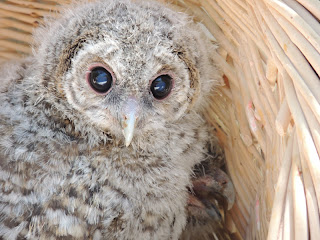My name is Whitney
Cowan and I wanted to tell our readers about the great experience I’ve had
working with the birds and people at the World Bird Sanctuary.
Before coming to the
sanctuary, I had absolutely no prior experience involving birds of prey, but of
course I realized that an internship at the World Bird Sanctuary would be an
awesome experience.
I never dreamed that an internship would evolve into a full-time job
I was born in Phoenix and
we moved to Missouri when I was about 5 years old and have lived outside the
town of Bland (it is a real townJ) ever since. Ever since I was young, I’ve had a deep love and respect
for all animals. As a child
growing up in the woods I was fortunate that I could spend most of my free time
with such animals as horses, cats, dogs, chickens, emus and others.
As a great many youngsters
do, I wanted to be a veterinarian because I wanted to have a career caring for
animals. However, after attending
college and getting a degree in Biological Science, I decided I wanted to have
a more hands-on day-to-day experience working with animals. Most vets only see
their patients for a short visit and then the animals go home. I wanted to be part of their lives on a
daily basis. I never imagined I
would be able to work so closely with the birds of prey at the World Bird
Sanctuary.
Initially I was introduced
to the Sanctuary by my brother Neal, He works in the Education Department at
the World Bird Sanctuary’s Nature Center and he suggested that I should apply
for an internship. After touring the facilities and seeing the birds kept
there, I definitely knew this was what I wanted.
When I started my
internship I was introduced to a variety of birds of prey. The best part was being able to carry
them on the glove! I learned a lot about the care of these birds, including
prepping their food and flying them for exercise. Working at the rehabilitation
hospital, in the Nature Center, and at the Training facilities was an
eye-opening experience that taught me about how the World Bird Sanctuary is
educating the public and helping to protect biodiversity.
My internship evolved into
a full time job, and I am now responsible for several birds of prey that WBS
keeps at Grant’s Farm for the Animal Encounter shows. I couldn’t be more
excited to have this opportunity to introduce these birds to the public and
show them the majesty of the Bald Eagle and the entrancing beauty of the Barn
Owl!
Stetson, the Harris' Hawk
One of the most exciting
experiences I’ve had because of my Grant’s Farm job has been training a Harris’
Hawk named Stetson. He has a set pattern of flights that involves flying to
perches above the audience, then flying back to
perches on the stage. We have certainly been through a lot of “practice”
flights before he got the routine down and nothing is quite as exciting as when
he flies a perfect pattern!
Submitted by Whitney Cowan
– Grant’s Farm Supervisor



















.jpg)






















